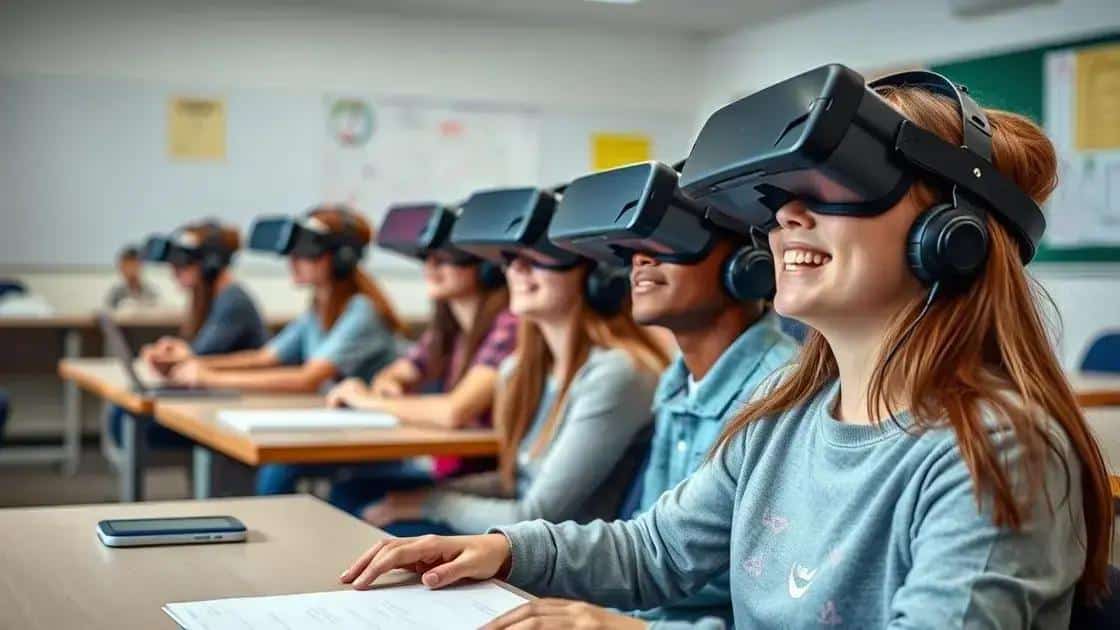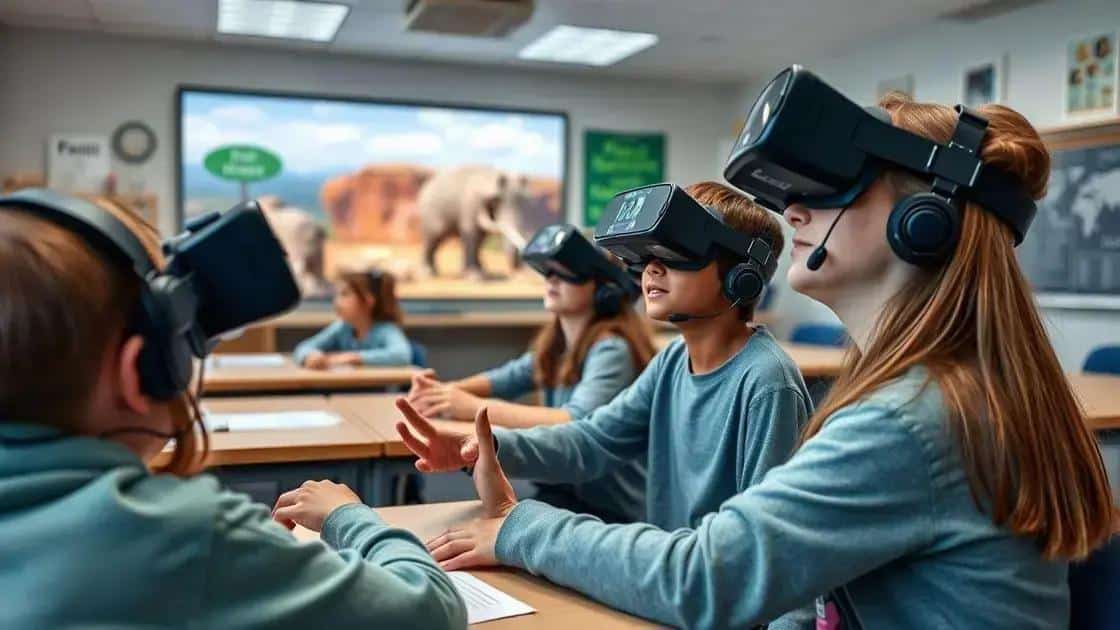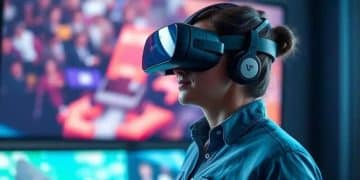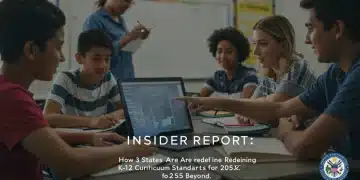Insights on vr learning environments transforming education

VR learning environments enhance education by providing immersive, interactive experiences that increase student engagement, improve retention, and allow for personalized learning through advanced technology and collaboration.
Insights on vr learning environments show how this technology is reshaping education. Have you ever wondered how virtual reality can bring lessons to life? Let’s dive into its impact!
Understanding vr learning environments
Understanding VR learning environments is essential in today’s technology-driven education landscape. They offer unique experiences that can enhance student engagement and comprehension. But what exactly are these environments? Let’s explore.
What are VR learning environments?
VR learning environments are immersive spaces created using virtual reality technology. They allow students to interact with a 3D world, which can transform traditional learning into exciting experiences. For instance, students can conduct science experiments, travel to historical sites, or explore the depths of the ocean—all from their classroom.
Benefits of VR in education
Using VR in education comes with numerous advantages:
- Increased Engagement: Students are more motivated to participate in lessons when they can experience learning actively.
- Enhanced Retention: Experiential learning helps students remember information better since they can visualize concepts in a practical context.
- Access to Unique Experiences: VR enables students to experience things that might be impossible in real life, such as space travel or historical re-enactments.
- Customizable Learning: VR environments can be tailored to fit diverse learning needs and preferences, making education more accessible.
The ability to create customized scenarios also empowers educators to address specific learning objectives more effectively. With the use of VR technology, teachers can simulate real-world situations that enhance critical thinking and problem-solving skills among students.
Moreover, the collaborative aspect of VR learning can encourage teamwork. Students can work together in a virtual space, promoting communication and social skills. In these environments, learners can tackle challenges as teams, reinforcing the lesson’s objectives. The potential for remote learning has also expanded, allowing students from different locations to connect and collaborate in shared virtual experiences.
As we continue to evolve with technology, understanding VR learning environments will play a crucial role in shaping future educational methods. By integrating this immersive technology into curricula, we can prepare students for a world that increasingly values innovation and adaptability.
Benefits of immersive education

The benefits of immersive education are numerous and can significantly enhance the learning experience for students. Immersive education offers an engaging approach that can transform traditional teaching methods into exciting adventures.
Enhanced Engagement
One of the main advantages of immersive education is the dramatic increase in student engagement. When learners can participate in interactive scenarios, they feel more invested in their education. For example, a history lesson might take students back to ancient Rome, allowing them to explore the environment and interact with virtual characters.
Improved Retention Rates
Immersive learning experiences can help improve retention rates as students actively participate in their education. This hands-on approach allows learners to connect with the material more meaningfully. Consider how much easier it is to remember experiences where learning was active rather than passive.
Access to Unique Learning Opportunities
Immersive education opens the door for unique learning moments that can inspire creativity and curiosity. With virtual and augmented reality, students can:
- Explore remote locations: Students can visit places like the Great Barrier Reef without leaving their classrooms.
- Experience complex concepts: Science lessons become tangible when students can visualize and interact with atomic structures.
- Engage with historical events: Students can participate in events like the signing of the Declaration of Independence, gaining a deeper understanding of their impact.
Additionally, the customizable nature of immersive education allows educators to tailor experiences to fit individual learning styles. This adaptability can enhance comprehension and ensure that each student gets the most out of their lessons.
Another significant benefit is the promotion of collaboration among students. Through immersive experiences, learners often work together to solve problems, which fosters teamwork and communication skills. Engaging in group activities presents opportunities for students to enhance their interpersonal skills in a fun and interactive way.
As a result, many educators are beginning to recognize the importance of incorporating immersive education into their curricula. This shift not only prepares students for the future but also equips them with necessary skills for the modern world.
Challenges in implementing vr in classrooms
Implementing VR technology in classrooms comes with several challenges that educators must address. While the benefits are clear, overcoming these obstacles is essential for a successful integration.
Cost and Budget Constraints
One of the main challenges is the cost associated with VR technology. Schools often operate on tight budgets, and investing in VR headsets, software, and maintenance can be a significant hurdle. The expense isn’t just for the equipment itself, but also for the training needed to help teachers effectively use these tools.
Technical Limitations
Technical difficulties can also arise when implementing VR in classrooms. Ensuring that the necessary infrastructure, such as high-speed internet and compatible devices, is in place can be a major task. Additionally, schools must consider the technical support needed to resolve any issues that may arise during lessons.
Another part of the technical challenge involves the range of VR content available. Not all subjects or topics have suitable immersive content, which can limit the effectiveness of VR in certain lessons. Without quality resources, teachers may find it difficult to fully utilize the technology.
Teacher Training and Comfort
Teachers play a crucial role in the successful adoption of VR. However, many educators may feel uncomfortable using new technology. Providing sufficient training sessions is important to ensure that teachers not only understand how to use the equipment but also feel confident integrating it into their teaching strategies.
Another concern is the potential for students to experience motion sickness during VR activities. While many users adapt, some students might find prolonged use difficult. Educators need to be aware of these sensitivities and adapt sessions accordingly to create a positive learning environment.
Lastly, finding the right balance between traditional teaching methods and immersive education is important. Teachers might struggle with incorporating VR into their existing curriculum without fully replacing effective teaching practices already in place. Striking this balance is essential for maintaining effective educational strategies.
Future trends in vr learning technology

The future of VR learning technology holds exciting possibilities that can further enhance education. As technology continues to evolve, we can expect significant changes in how VR is utilized in classrooms.
Integration of Artificial Intelligence
One of the emerging trends is the integration of artificial intelligence (AI) with VR technology. AI can provide personalized learning experiences, adapting the content according to each student’s needs and pace. Imagine a virtual tutor guiding a student through complex subjects, offering tailored hints and explanations.
Increasing Accessibility
As VR technology advances, its accessibility is also improving. Schools are likely to see more affordable options, making it easier to implement VR into their curriculums. Additionally, advancements in mobile VR can allow students to learn anywhere, making education more flexible.
Enhanced Collaborative Learning
Future VR environments will likely support enhanced collaborative learning. Students from different locations will be able to join virtual classrooms, working together in real-time on projects. This collaboration encourages teamwork and communication skills, crucial for modern workplaces.
Furthermore, immersive experiences will expand beyond the classroom. Project-based learning in virtual environments might allow students to tackle real-world problems, fostering critical thinking and creativity. For instance, students could participate in virtual community projects, learning about social responsibility while collaborating on solutions.
Gamification of Learning
Another trend is the gamification of learning in VR. By integrating game mechanics into educational experiences, students may find learning more engaging and fun. This method can motivate students to track their progress, earn rewards, and challenge themselves in a competitive yet supportive environment.
As VR technology continues to merge with other innovative tools, educators will have a wealth of resources at their disposal to enhance the learning experience. Staying updated on these advancements will be essential for teachers who want to provide the best educational opportunities possible.
In summary, the integration of VR learning environments is transforming education in exciting ways. While challenges remain, the future trends indicate greater accessibility, enhanced collaboration, and personalized learning experiences. By embracing these advancements, educators can create dynamic classrooms that engage and inspire students. As technology evolves, it will continue to shape the way we learn, making education more interactive and impactful.
FAQ – Frequently Asked Questions about VR Learning Environments
What are VR learning environments?
VR learning environments are immersive spaces where students can interact with 3D worlds to enhance their understanding and engagement in various subjects.
How can VR technology improve student learning?
VR technology can improve student learning by providing interactive and engaging experiences that help students retain information better while participating actively.
What are the common challenges in implementing VR in classrooms?
Common challenges include high costs, technical limitations, ensuring teacher training, and addressing potential motion sickness among students.
What future trends can we expect in VR learning technology?
Future trends include increased integration of AI for personalized learning, enhanced collaboration among students, greater accessibility, and gamification of educational content.





